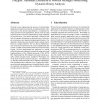Free Online Productivity Tools
i2Speak
i2Symbol
i2OCR
iTex2Img
iWeb2Print
iWeb2Shot
i2Type
iPdf2Split
iPdf2Merge
i2Bopomofo
i2Arabic
i2Style
i2Image
i2PDF
iLatex2Rtf
Sci2ools
CCS
2007
ACM
2007
ACM
Polyglot: automatic extraction of protocol message format using dynamic binary analysis
Protocol reverse engineering, the process of extracting the application-level protocol used by an implementation, without access to the protocol specification, is important for many network security applications. Recent work [17] has proposed protocol reverse engineering by using clustering on network traces. That kind of approach is limited by the lack of semantic information on network traces. In this paper we propose a new approach using program binaries. Our approach, shadowing, uses dynamic binary analysis and is based on a unique intuition—the way that an implementation of the protocol processes the received application data reveals a wealth of information about the protocol message format. We have implemented our approach in a system called Polyglot and evaluated it extensively using real-world implementations of five different protocols: DNS, HTTP, IRC, Samba and ICQ. We compare our results with the manually crafted message format, included in Wireshark, one of the state-o...
Application-level Protocol | CCS 2007 | Network Traces | Protocol Reverse Engineering | Security Privacy |
| Added | 07 Jun 2010 |
| Updated | 07 Jun 2010 |
| Type | Conference |
| Year | 2007 |
| Where | CCS |
| Authors | Juan Caballero, Heng Yin, Zhenkai Liang, Dawn Xiaodong Song |
Comments (0)

